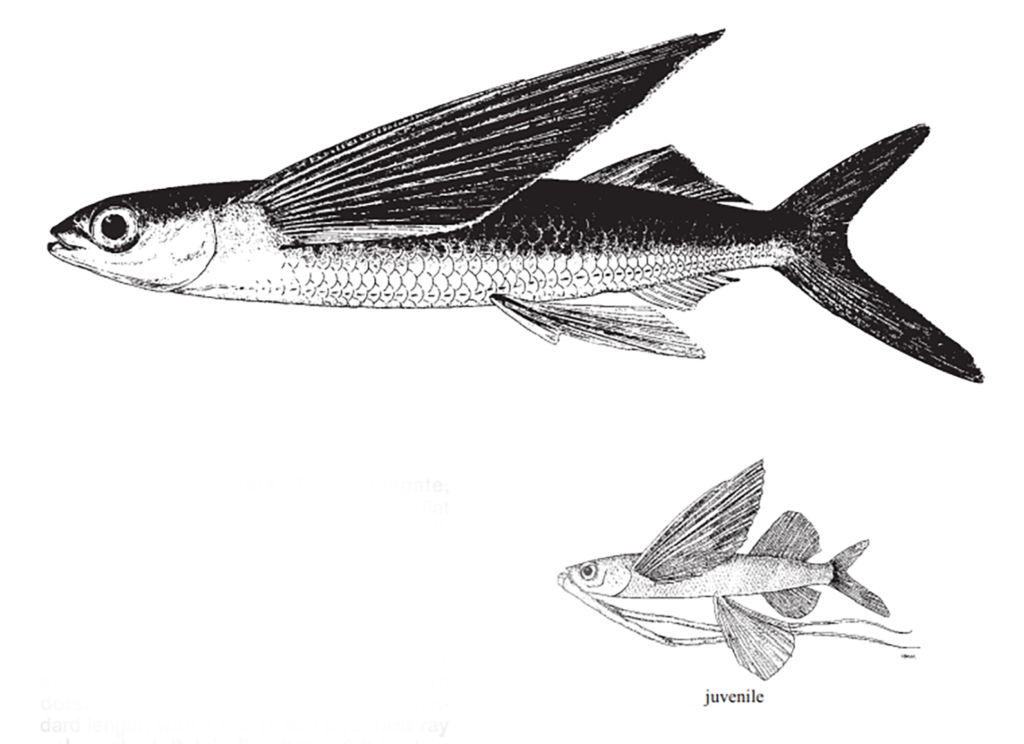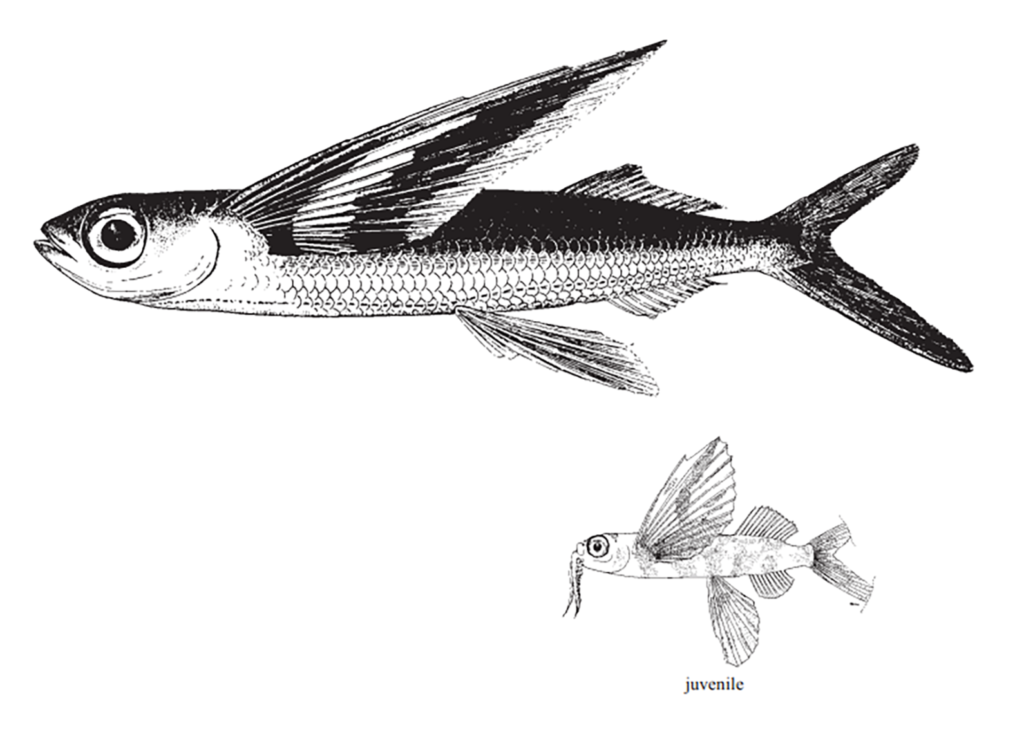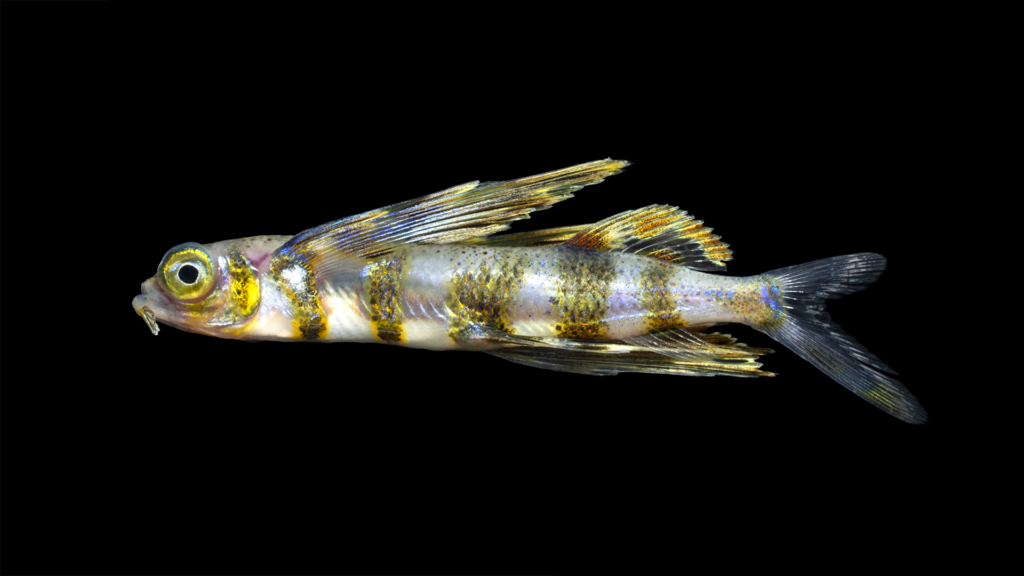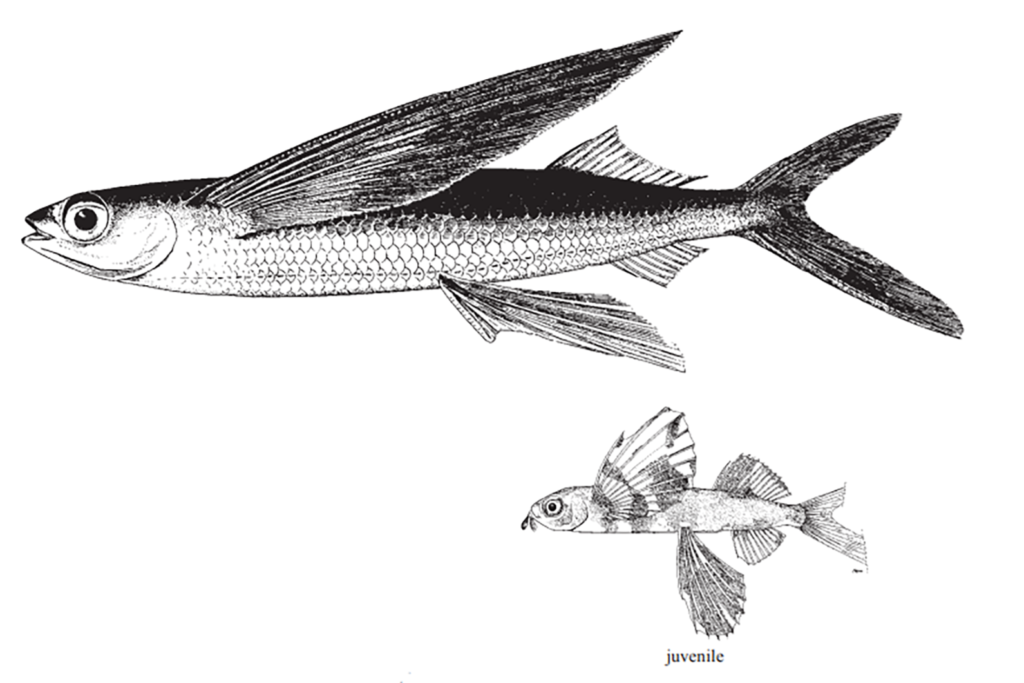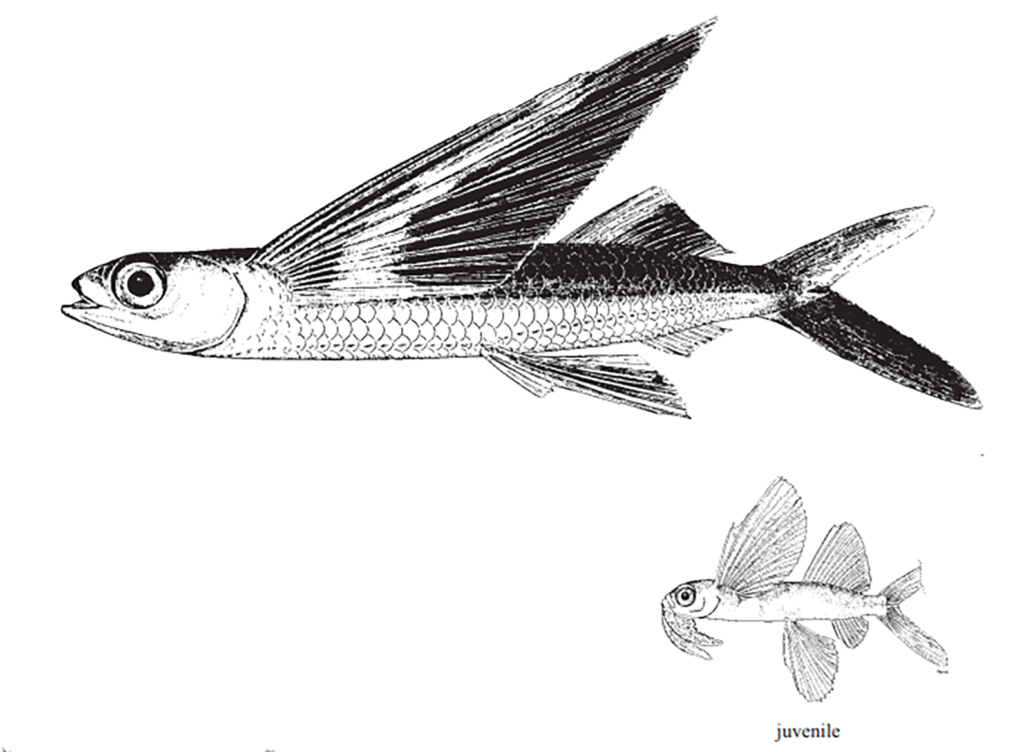
Source: FAO 2002
| Family | Scientific Name | Author | Year | Common Name |
| Exocoetidae | Cheilopogon exsiliens | (Linnaeus) | 1771 | Bandwing Flyingfish |
Cheilopogon exsiliens
Unique Characteristics: Dorsal fin moderately high (longest soft ray usually less than 10 times in standard length), bearing a prominent black spot. Pectoral fins black with a definite pale crossband. Lower caudal-fin lobe obviously darker than upper lobe. Pectoral fins very long, reaching beyond anal-fin base to or almost to caudal-fin base. Pectoral branch of lateral line absent. Pelvic fins long, reaching well beyond anal-fin origin, inserted nearer to anal-fin origin than pectoral-fin insertion. Origin of anal fin 3 soft rays or more behind origin of dorsal fin. Dorsal fin 2-5 soft rays more than anal fin. Only the first pectoral-fin ray unbranched. Pelvic fins inserted much nearer to posterior head margin than origin of lower caudal-fin lobe. Both jaws of equal length, or lower jaw a little longer than upper jaw. Pectoral fins more densely pigmented, usually with paler transverse strip or basal triangle. Palatine teeth present; jaw teeth noticeable (conspicuous to the touch). Predorsal scales 24-29. Juveniles with moderately long, paired, flat chin barbels, their length more than 2.5 times in standard length.
Similar Species:
Margined Flyingfish
Cheilopogon cyanopterus
Spotfin Flyingfish
Cheilopogon furcatus
Margined Flyingfish Cheilopogon cyanopterus. Dorsal fin moderately high (longest soft ray usually less than 10 times in standard length), bearing a prominent black spot. Both caudal-fin lobes equally pigmented and dusky. Pectoral fins uniformly bluish black except for white outer margin and lowermost soft rays. Pectoral fins very long, reaching beyond anal-fin base to or almost to caudal-fin base. Pectoral branch of lateral line absent. Pelvic fins long, reaching well beyond anal-fin origin, inserted nearer to anal-fin origin than pectoral-fin insertion. Origin of anal fin 3 soft rays or more behind origin of dorsal fin. Dorsal fin 2-5 soft rays more than anal fin. Only the first pectoral-fin ray unbranched. Both jaws of equal length, or lower jaw a little longer than upper jaw. Pectoral fins more densely pigmented. Palatine teeth present; jaw teeth noticeable (conspicuous to the touch). Predorsal scales 33-41. Juveniles with very long, paired chin barbels with fleshy axis, their length less than 1.7 times in standard length.
Spotfin Flyingfish Cheilopogon furcatus. Dorsal fin moderately low (longest soft ray usually more than 10 times in standard length), without black spot. Pectoral fin usually blackish, with definite pale crossband and broad outer margin. Pectoral fins very long, reaching beyond anal-fin base to or almost to caudal-fin base. Pectoral branch of lateral line absent. Pelvic fins long, reaching well beyond anal-fin origin, inserted nearer to anal-fin origin than pectoral-fin insertion. Origin of anal fin 3 soft rays or more behind origin of dorsal fin. Dorsal fin 2-5 soft rays more than anal fin. Only the first pectoral-fin ray unbranched. Pelvic fins inserted much nearer to posterior head margin than origin of lower caudal-fin lobe. Both jaws of equal length, or lower jaw a little longer than upper jaw. Pectoral fins more densely pigmented, usually with paler transverse strip or basal triangle. Palatine teeth absent; jaw teeth minute (not conspiciuous to the touch). Juveniles with moderately long, paired chin barbels, their length less than 2.7 times in standard length.
Atlantic Flyingfish
Cheilopogon melanurus
Blotchwing Flyingfish
Cheilopogon heterurus
Atlantic Flyingfish Cheilopogon melanurus. Dorsal fin moderately low (longest soft ray usually more than 10 times in standard length), without black spot. Pectoral fins greyish, with indefinite pale triangular crossband and narrow outer margin. Caudal fin dusky. Pectoral fins very long, reaching beyond anal-fin base to or almost to caudal-fin base. Pectoral branch of lateral line absent. Pelvic fins long, reaching well beyond anal-fin origin, inserted nearer to anal-fin origin than pectoral-fin insertion. Origin of anal fin 3 soft rays or more behind origin of dorsal fin. Dorsal fin 2-5 soft rays more than anal fin. Only the first pectoral-fin ray unbranched. Pelvic fins inserted much nearer to posterior head margin than origin of lower caudal-fin lobe. Both jaws of equal length, or lower jaw a little longer than upper jaw. Pectoral fins more densely pigmented, usually with paler transverse strip or basal triangle.Palatine teeth absent; jaw teeth minute (not conspiciuous to the touch). Juveniles with paired, short chin barbels, their length more than 7 times in standard length. Head length 3.9-4.6, usually less than 4.3 in standard length. Predorsal scales 25-33, usually 27-30.
Blotchwing Flyingfish Cheilopogon heterurus. Dorsal fin moderately low (longest soft ray usually more than 10 times in standard length), without black spot. Pectoral fins greyish, with indefinite pale triangular crossband and narrow outer margin. Pectoral fins very long, reaching beyond anal-fin base to or almost to caudal-fin base. Pectoral branch of lateral line absent. Pelvic fins long, reaching well beyond anal-fin origin, inserted nearer to anal-fin origin than pectoral-fin insertion. Origin of anal fin 3 soft rays or more behind origin of dorsal fin. Dorsal fin 2-5 soft rays more than anal fin. Only the first pectoral-fin ray unbranched. Pelvic fins inserted much nearer to posterior head margin than origin of lower caudal-fin lobe. Both jaws of equal length, or lower jaw a little longer than upper jaw. Pectoral fins more densely pigmented, usually with paler transverse strip or basal triangle. Palatine teeth absent; jaw teeth minute (not conspiciuous to the touch). Juveniles with paired short, chin barbels, their length more than 7 times in standard length. Head length 4.3-4.9, usually more than 4.5 in standard length. Predorsal scales 29-38, usually 30-35.
Gallery
